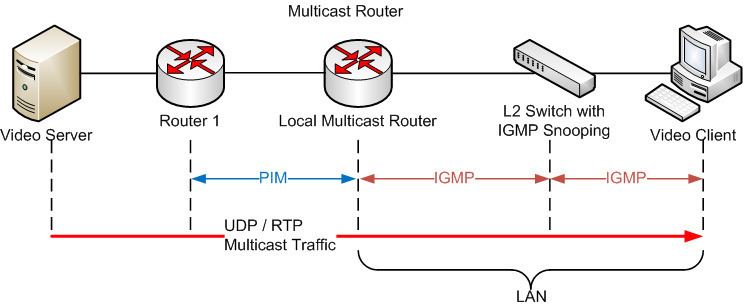 | ||
The Internet Group Management Protocol (IGMP) is a communications protocol used by hosts and adjacent routers on IPv4 networks to establish multicast group memberships. IGMP is an integral part of IP multicast.
Contents
- Architecture
- Standards
- Packet structure
- IGMPv2 messages
- IGMPv3 membership query
- Implementations
- References
IGMP can be used for one-to-many networking applications such as online streaming video and gaming, and allows more efficient use of resources when supporting these types of applications.
IGMP is used on IPv4 networks. Multicast management on IPv6 networks is handled by Multicast Listener Discovery (MLD) which uses ICMPv6 messaging in contrast to IGMP's bare IP encapsulation.
Architecture
A network designed to deliver a multicast service using IGMP might use this basic architecture:
IGMP operates between the client computer and a local multicast router. Switches featuring IGMP snooping derive useful information by observing these IGMP transactions. Protocol Independent Multicast (PIM) is then used between the local and remote multicast routers, to direct multicast traffic from the multicast server to many multicast clients.
IGMP operates on the network layer, just the same as other network management protocols like ICMP.
The IGMP protocol is implemented on a particular host and within a router. A host requests membership to a group through its local router while a router listens for these requests and periodically sends out subscription queries. A single router per subnet is elected to perform this querying function. Some multilayer switches include an IGMP querier capability to allow their IGMP snooping features to work in the absence of an IP multicast capability in the larger network.
IGMP is vulnerable to some attacks, and firewalls commonly allow the user to disable it if not needed.
Standards
There are three versions of IGMP, as defined by Request for Comments (RFC) documents of the Internet Engineering Task Force (IETF). IGMPv1 is defined by RFC 1112, IGMPv2 is defined by RFC 2236 and IGMPv3 was initially defined by RFC 3376 and has been updated by RFC 4604 which defines both IGMPv3 and MLDv2. IGMPv2 improves over IGMPv1 by adding the ability for a host to signal desire to leave a multicast group. IGMPv3 improves over IGMPv2 mainly by supporting source-specific multicast and Membership Report aggregation.
Packet structure
IGMP messages are carried in bare IP packets with IP protocol number 2. There is no transport layer used with IGMP messaging, similar to the Internet Control Message Protocol.
There are several types of IGMP messages: Membership Queries (general and group-specific), Membership Reports, and Leave Group messages.
Membership Queries are sent by multicast routers to determine which multicast addresses are of interest to systems attached to its network. Routers periodically send General Queries to refresh the group membership state for all systems on its network. Group-Specific Queries are used for determining the reception state for a particular multicast address. Group-and-Source-Specific Queries allow the router to determine if any systems desire reception of messages sent to a multicast group from a source address specified in a list of unicast addresses.
IGMPv2 messages
Where:
The message is sent to following IP addresses:
IGMPv3 membership query
Where:
Implementations
The FreeBSD, Linux and Windows operating systems support IGMP at the host side.
